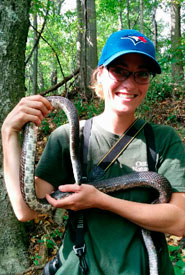One human's trash is an endangered snake's treasure
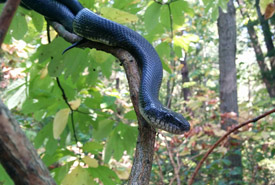
Gray ratsnake (Photo by Jessica Ferguson)
I spent my summer radio-tracking a female gray ratsnake and assessing habitat characteristics in Norfolk County, for Natural Resource Solutions Inc. (NRSI), an ecological consulting company based in Waterloo, Ontario, and Ontario Nature, a charitable organization based in Toronto. Our research aims to better understand gray ratsnake habitat preferences and movement patterns to assist important recovery actions for the species. By tracking captured ratsnakes that have been fitted with radio-transmitters, valuable information can be learned about what key habitat features this species requires.
In late September, I found myself on a Nature Conservancy of Canada (NCC) property at the base of a ravine, peering up at a large rubble pile. I suspected the pile was the entrance to an underground overwintering refuge, called a hibernaculum, for this endangered species.
Two populations of gray ratsnake exist in Ontario: the Frontenac-Axis and Carolinian populations. Our work focuses on the Big Creek subpopulation within the Carolinian region. The gray ratsnake faces many threats, including habitat loss, road mortality and human persecution. Our research will identify important habitat characteristics to help inform land management and stewardship decisions for these endangered snakes.
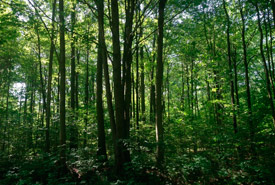
Carolinian forest. (Photo by Jody Allair)
Finding gray ratsnakes in the Carolinian region is really, really rare. Only one or two sightings are reported each year to the Ontario Reptile and Amphibian Atlas. Most years yield no sightings at all. This was echoed when I visited the Norfolk Field Naturalists meeting in May; naturalists that had explored Norfolk for more than 40 years reported seeing one or two in their lives, if any.
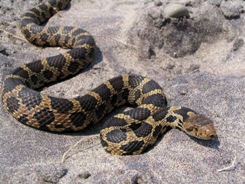
Eastern fox snake (Photo by Ryan M. Bolton)
To help us find gray ratsnakes, we applied a Habitat Suitability Index model, developed by NCC, which identifies and maps suitable habitat and informs survey locations. Preliminary results indicate that only 0.45 per cent of the total area in Norfolk County consists of suitable habitat for gray ratsnake. In comparison, 10.8 per cent of the land cover in the county provides suitable habitat for eastern foxsnake — another endangered snake species within the Carolinian region. Thus, suitable gray ratsnake habitat is relatively limited in Norfolk County because of land use change, habitat degradation and fragmentation by roads.
Gray ratsnakes are known to prefer mature deciduous forest edges and spend much of their time basking in trees. Our research confirmed this behaviour. The female snake we were tracking would spend up to two weeks at a time in one tree, often returning to the same trees multiple times throughout the season. We found that she preferred mature trees, but the species of tree did not matter. We found her in all sorts of trees, including largetooth aspen, black cherry, Freeman’s maple, sassafras and eastern white pine. One common element was that each of the trees had a deep cavity or snag limb, suggesting that continued protection of mature Carolinian forest is imperative for future persistence of the gray ratsnake population.
Another important part of this research is to identify hibernacula, to help locate and protect safe spots for snakes to overwinter. For the gray ratsnakes we were tracking, the hibernaculum happened to be made by humans. Likely, the previous landowner had dumped cement blocks off the ravine edge. Soil filled in around the cement and created ideal features for hibernating snakes — deep burrows that offered protection below the frost line, but above the water table. This “life zone” provides the right combination of oxygen and humidity, allowing snakes to survive our harsh Canadian winters.
On that warm September day, looking up at the rubble and contemplating whether the location had the right features to be a hibernaculum, I suddenly saw movement. A thick, shiny, black snake stretched across a fallen tree popped out at me. After months of surveys in suitable habitat, I had found our third individual snake! Before I picked it up to take its measurements and fit it with a transmitter, I took a few moments to take in the scene, enthralled at the snake’s size and lackadaisical nature.
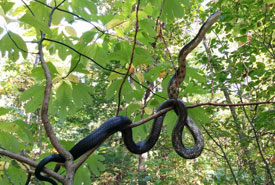
Gray ratsnake (Photo by Jessica Ferguson)
In October, we confirmed the ravine pile as a hibernaculum, by tracking two of our snakes to this same feature, where they stayed underground. What was once one person’s garbage is now a safe location for endangered snakes to overwinter. Although wildlife will often use artificial items in this way, it is not necessarily their preferred habitat. Fallen logs and leaf litter do just fine, and may provide more suitable humidity and temperature regimes in the long run than some human-made materials. NCC’s work to protect and restore natural habitat may reduce reliance on sometimes unsuitable, artificial habitats. Thanks to the protection of habitat by NCC, the hibernaculum and the mature deciduous forest surrounding it will persist, and continue to offer protection for endangered gray ratsnakes.
Funding was provided by the Ontario Ministry of Natural Resources and Forestry Species-at-Risk Stewardship Fund and the Environment Canada Habitat Stewardship Fund.

